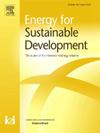发展中经济体现有建筑向绿色建筑过渡:斯里兰卡案例
IF 4.4
2区 工程技术
Q2 ENERGY & FUELS
引用次数: 0
摘要
将现有建筑转型为绿色建筑是一项积极措施,可减轻能源过度消耗和温室气体排放的不利影响。然而,发展中经济体对现有建筑升级改造的贡献似乎尚未得到显著关注。从这个意义上讲,本文旨在以斯里兰卡发展中经济体为基础,解决三个知识缺口:1)确定发展中经济体采用绿色建筑的障碍;2)研究这些障碍之间的相互关系;以及 3)针对每个障碍提出策略并将相关利益方联系起来。对经验丰富的专业人员进行了半结构式访谈和重点小组讨论,并采用解释性结构建模(ISM)方法对收集的数据进行了分析。分析结果表明,由于对自然的依赖程度最高,社会障碍最容易克服。因此,针对其他障碍的缓解策略显然有助于消除社会障碍。然而,必须下大力气解决独立障碍,即监管、技术和信息障碍。本研究从每种障碍之间的因果关系和驱动策略的角度,推进了对绿色改造的认识,可帮助学术界和实践者实现更多的绿色改造应用。本文章由计算机程序翻译,如有差异,请以英文原文为准。
Transitioning of existing buildings to green in developing economies: A case of Sri Lanka
Transitioning existing buildings to green is a proactive measure to mitigate the adverse effects of excessive energy consumption and greenhouse gas emissions. However, it seems that the contribution of developing economies to upgrade the existing buildings has not yet been focused significantly. In this sense, this paper aims to address the three knowledge gaps based on the Sri Lankan developing economy; 1) Identify the adoption barriers in developing economies, 2) Examine the interrelationship between the barriers, and 3) Propose the strategies and link respective stakeholders with each barrier. Semi-structured interviews and focused group discussions were conducted with experienced professionals and collected data were analysed using the Interpretive Structural Modelling (ISM) approach. Analysis results identified that the social barriers are the most easily surmountable due to having the highest reliance on nature. Hence, mitigation strategies on other barriers obviously help to combat the social barriers. However, a significant effort must be made to address the independent barriers; regulatory, technological, and informational. This study advances the knowledge of green retrofitting in terms of the causality among each barrier and driving strategies that may assist both academics and practitioners towards the realisation of more green retrofitting adoption.
求助全文
通过发布文献求助,成功后即可免费获取论文全文。
去求助
来源期刊

Energy for Sustainable Development
ENERGY & FUELS-ENERGY & FUELS
CiteScore
8.10
自引率
9.10%
发文量
187
审稿时长
6-12 weeks
期刊介绍:
Published on behalf of the International Energy Initiative, Energy for Sustainable Development is the journal for decision makers, managers, consultants, policy makers, planners and researchers in both government and non-government organizations. It publishes original research and reviews about energy in developing countries, sustainable development, energy resources, technologies, policies and interactions.
 求助内容:
求助内容: 应助结果提醒方式:
应助结果提醒方式:


